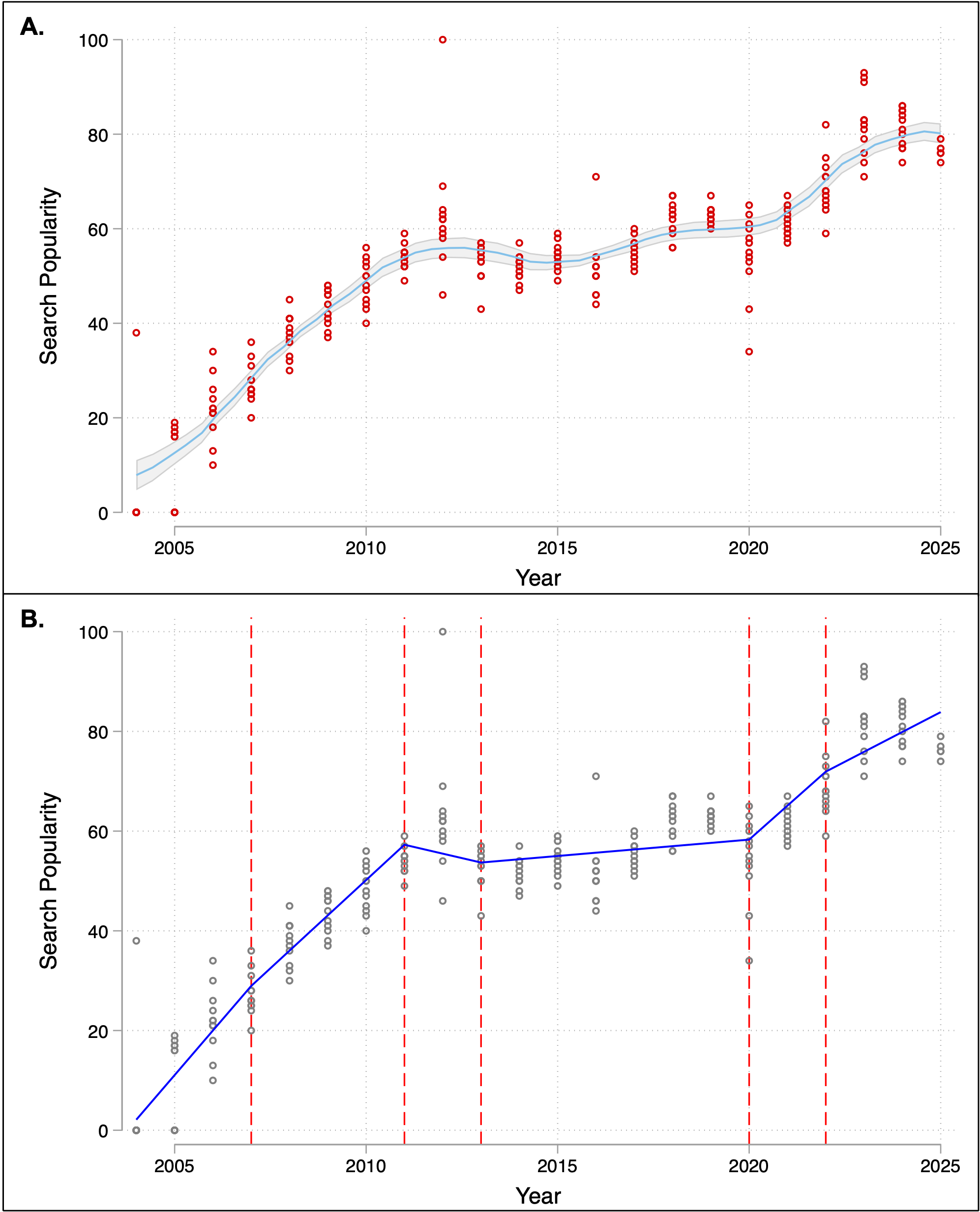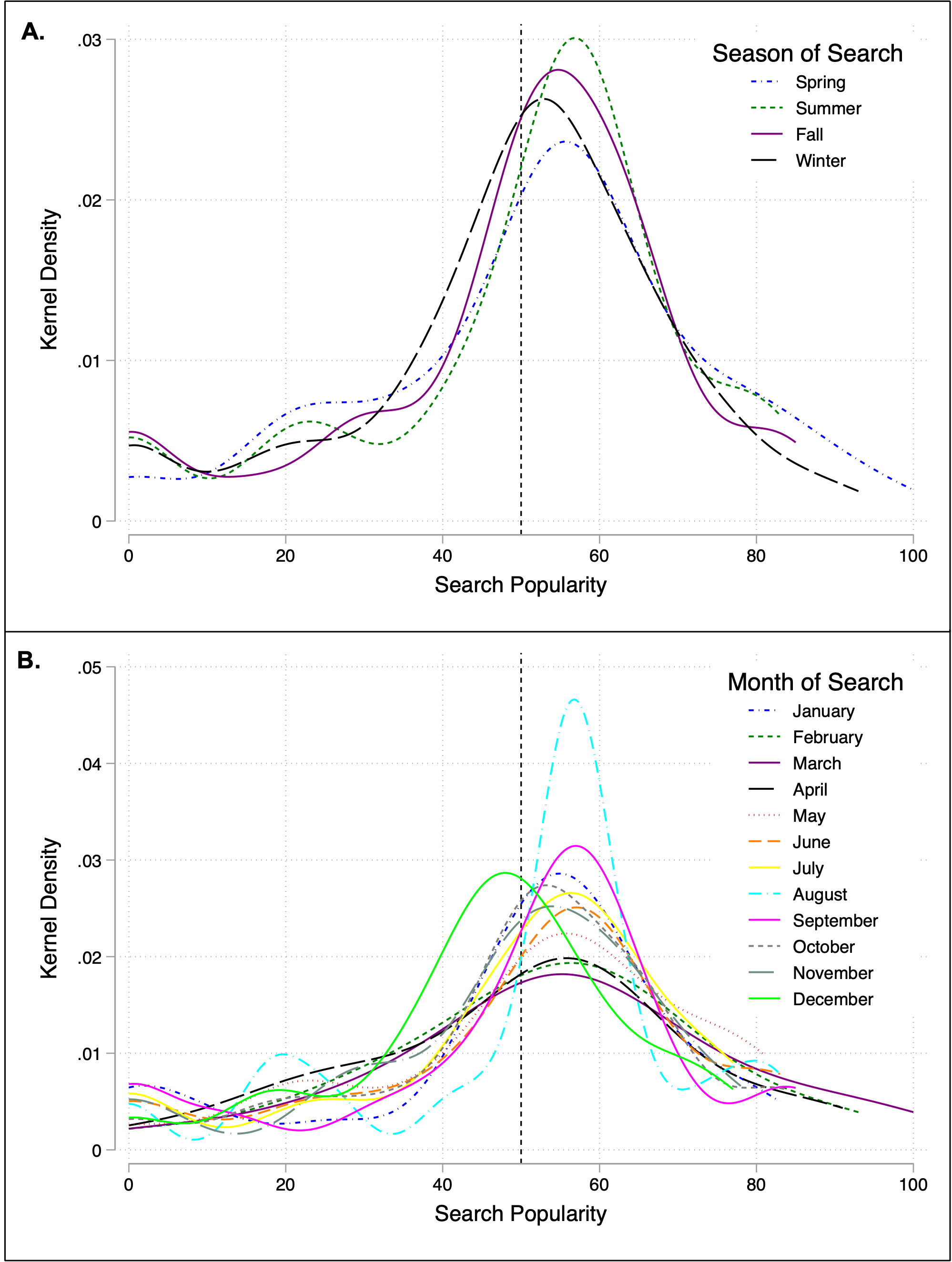Monday Poster Session
Category: Esophagus
P2742 - Google Search Patterns for Eosinophilic Esophagitis Fluctuate in Response to Clinical Milestones and Seasonal Variation
Monday, October 27, 2025
10:30 AM - 4:00 PM PDT
Location: Exhibit Hall

Corey J. Ketchem, MD
University of Pennsylvania Health System
CHICAGO, IL
Presenting Author(s)
Corey J. Ketchem, MD1, Evan S. Dellon, MD, MPH2
1University of Pennsylvania Health System, Philadelphia, PA; 2Center for Esophageal Diseases and Swallowing, University of North Carolina School of Medicine, Chapel Hill, NC
Introduction: Eosinophilic esophagitis (EoE) is a chronic, immune-mediated disease that is increasing in prevalence. Whether public searches for EoE mirror this pattern is unknown. We aimed to analyze temporal patterns of Google search popularity for EoE.
Methods: We used Google Trends, an online tool that indexes the popularity of search queries from 0 to 100, with 100 representing peak popularity within a selected timeframe and location. We examined trends for the term "eosinophilic esophagitis" spanning January 2004 through April 2025 in the United States. Temporal trends were analyzed using locally weighted regression (lpoly), and R-squared values quantified the association between year and search popularity. Segmented linear regression was conducted to assess changes over time, with breakpoints defined at key guideline or treatment milestones (2007, 2011, 2013, 2020, and 2022). Interaction terms were created for each breakpoint to estimate slope changes. Kernel density estimation was used to visualize monthly and seasonal variation.
Results: Temporal trends of EoE search popularity revealed a substantial and consistent increase from 2004 to 2023 (R-squared 0.74, p< 0.001), with a particularly steep rise in the last 5 years (Figure 1A). Examination of EoE search popularity following major milestones revealed the greatest increases following the years 2007 (7.1; 95% CI: 6.0,8.2; p< 0.001), 2020 (6.8; 95% CI: 4.7,8.9; p< 0.001), and 2022 (4.0; 95% CI: 2.0,6.0; p< 0.001). The kernel density plots demonstrated variability in search interest for EoE by month, with August having the highest and December having the lowest peak search interest. Seasonal variation also existed, with Summer and Fall showing the highest density of search popularity. Spring had the broadest variability in distribution of search popularity, while winter exhibited a lower, more stable search pattern.
Discussion: Google search trends indicate rising interest in EoE over time, with notable seasonal peaks in Spring and Summer, potentially reflecting allergy-related symptom flares. Increases in search activity followed key clinical milestones, including the 2007 diagnostic guidelines, 2020 treatment guidelines, and the 2022 guideline update coinciding with dupilumab approval. These findings highlight EoE as a public health concern and demonstrate the value of digital epidemiology in monitoring disease awareness and informing strategies to improve diagnosis and care.

Figure: Figure 1. (A) Google search popularity for EoE by year. (B) Segmented linear regression model of EoE search popularity with breakpoints at major guideline and treatment milestones (2007, 2011, 2013, 2020, and 2022), indicated by dashed red vertical lines.

Figure: Figure 2. Kernel density plots of Google search popularity for EoE by (A) season and (B) month.
Disclosures:
Corey Ketchem indicated no relevant financial relationships.
Evan Dellon: AbbVie – Consultant. Adare/Ellodi – Consultant, Grant/Research Support. Akesobio – Consultant. Alfasigma – Consultant. ALK – Consultant. Allakos – Consultant, Grant/Research Support. Amgen – Consultant. Apogee – Consultant. Apollo – Consultant. Aqilion – Consultant, Grant/Research Support. Arena/Pfizer – Consultant, Grant/Research Support. Aslan – Consultant. AstraZeneca – Consultant, Grant/Research Support. Avir – Consultant. Biocryst – Consultant. Bryn – Consultant. Calypso – Consultant. Celgene/Receptos/Bristol Myers Squibb – Consultant, Grant/Research Support. Celldex – Consultant, Grant/Research Support. Dr. Falk Pharma – Consultant. EsoCap – Consultant. Eupraxia – Consultant, Grant/Research Support. Ferring – Consultant, Grant/Research Support. GI Reviewers – Consultant. GSK – Consultant, Grant/Research Support. Holoclara – Consultant, Grant/Research Support. Invea – Consultant, Grant/Research Support. Knightpoint – Consultant. LucidDx – Consultant. Meritage – Grant/Research Support. Miraca – Grant/Research Support. Morphic – Consultant. Nexstone Immunology/Uniquity – Consultant. Nutricia – Consultant, Grant/Research Support. Parexel/Calyx – Consultant. Phathom – Consultant. Regeneron Pharmaceuticals Inc. – Consultant, Grant/Research Support. Revolo – Consultant, Grant/Research Support. Robarts/Alimentiv – Consultant. Sanofi – Consultant, Grant/Research Support. Shire/Takeda – Consultant, Grant/Research Support. Target RWE – Consultant. Third Harmonic Bio – Consultant. Uniquity – Grant/Research Support. Upstream Bio – Consultant.
Corey J. Ketchem, MD1, Evan S. Dellon, MD, MPH2. P2742 - Google Search Patterns for Eosinophilic Esophagitis Fluctuate in Response to Clinical Milestones and Seasonal Variation, ACG 2025 Annual Scientific Meeting Abstracts. Phoenix, AZ: American College of Gastroenterology.
1University of Pennsylvania Health System, Philadelphia, PA; 2Center for Esophageal Diseases and Swallowing, University of North Carolina School of Medicine, Chapel Hill, NC
Introduction: Eosinophilic esophagitis (EoE) is a chronic, immune-mediated disease that is increasing in prevalence. Whether public searches for EoE mirror this pattern is unknown. We aimed to analyze temporal patterns of Google search popularity for EoE.
Methods: We used Google Trends, an online tool that indexes the popularity of search queries from 0 to 100, with 100 representing peak popularity within a selected timeframe and location. We examined trends for the term "eosinophilic esophagitis" spanning January 2004 through April 2025 in the United States. Temporal trends were analyzed using locally weighted regression (lpoly), and R-squared values quantified the association between year and search popularity. Segmented linear regression was conducted to assess changes over time, with breakpoints defined at key guideline or treatment milestones (2007, 2011, 2013, 2020, and 2022). Interaction terms were created for each breakpoint to estimate slope changes. Kernel density estimation was used to visualize monthly and seasonal variation.
Results: Temporal trends of EoE search popularity revealed a substantial and consistent increase from 2004 to 2023 (R-squared 0.74, p< 0.001), with a particularly steep rise in the last 5 years (Figure 1A). Examination of EoE search popularity following major milestones revealed the greatest increases following the years 2007 (7.1; 95% CI: 6.0,8.2; p< 0.001), 2020 (6.8; 95% CI: 4.7,8.9; p< 0.001), and 2022 (4.0; 95% CI: 2.0,6.0; p< 0.001). The kernel density plots demonstrated variability in search interest for EoE by month, with August having the highest and December having the lowest peak search interest. Seasonal variation also existed, with Summer and Fall showing the highest density of search popularity. Spring had the broadest variability in distribution of search popularity, while winter exhibited a lower, more stable search pattern.
Discussion: Google search trends indicate rising interest in EoE over time, with notable seasonal peaks in Spring and Summer, potentially reflecting allergy-related symptom flares. Increases in search activity followed key clinical milestones, including the 2007 diagnostic guidelines, 2020 treatment guidelines, and the 2022 guideline update coinciding with dupilumab approval. These findings highlight EoE as a public health concern and demonstrate the value of digital epidemiology in monitoring disease awareness and informing strategies to improve diagnosis and care.

Figure: Figure 1. (A) Google search popularity for EoE by year. (B) Segmented linear regression model of EoE search popularity with breakpoints at major guideline and treatment milestones (2007, 2011, 2013, 2020, and 2022), indicated by dashed red vertical lines.

Figure: Figure 2. Kernel density plots of Google search popularity for EoE by (A) season and (B) month.
Disclosures:
Corey Ketchem indicated no relevant financial relationships.
Evan Dellon: AbbVie – Consultant. Adare/Ellodi – Consultant, Grant/Research Support. Akesobio – Consultant. Alfasigma – Consultant. ALK – Consultant. Allakos – Consultant, Grant/Research Support. Amgen – Consultant. Apogee – Consultant. Apollo – Consultant. Aqilion – Consultant, Grant/Research Support. Arena/Pfizer – Consultant, Grant/Research Support. Aslan – Consultant. AstraZeneca – Consultant, Grant/Research Support. Avir – Consultant. Biocryst – Consultant. Bryn – Consultant. Calypso – Consultant. Celgene/Receptos/Bristol Myers Squibb – Consultant, Grant/Research Support. Celldex – Consultant, Grant/Research Support. Dr. Falk Pharma – Consultant. EsoCap – Consultant. Eupraxia – Consultant, Grant/Research Support. Ferring – Consultant, Grant/Research Support. GI Reviewers – Consultant. GSK – Consultant, Grant/Research Support. Holoclara – Consultant, Grant/Research Support. Invea – Consultant, Grant/Research Support. Knightpoint – Consultant. LucidDx – Consultant. Meritage – Grant/Research Support. Miraca – Grant/Research Support. Morphic – Consultant. Nexstone Immunology/Uniquity – Consultant. Nutricia – Consultant, Grant/Research Support. Parexel/Calyx – Consultant. Phathom – Consultant. Regeneron Pharmaceuticals Inc. – Consultant, Grant/Research Support. Revolo – Consultant, Grant/Research Support. Robarts/Alimentiv – Consultant. Sanofi – Consultant, Grant/Research Support. Shire/Takeda – Consultant, Grant/Research Support. Target RWE – Consultant. Third Harmonic Bio – Consultant. Uniquity – Grant/Research Support. Upstream Bio – Consultant.
Corey J. Ketchem, MD1, Evan S. Dellon, MD, MPH2. P2742 - Google Search Patterns for Eosinophilic Esophagitis Fluctuate in Response to Clinical Milestones and Seasonal Variation, ACG 2025 Annual Scientific Meeting Abstracts. Phoenix, AZ: American College of Gastroenterology.
